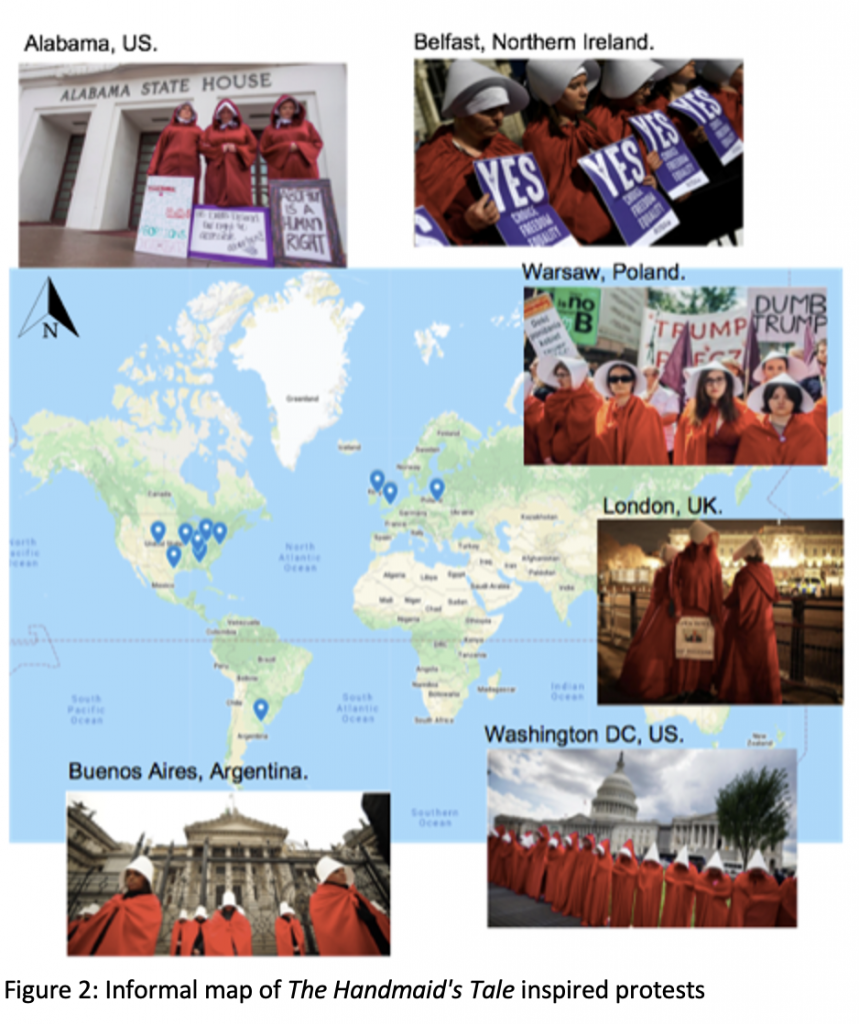Georgia Silva, University of Nottingham, 2020 Dissertation Prize Winner
This dissertation uses Margaret Atwood’s novels The Handmaid’s Tale (1985) and The Testaments (2019) alongside Hulu’s television adaptation as sites for geographical research. It explores textual and visual representations of power and resistance within the fictional world of Gilead and within society today. The Republic of Gilead is a totalitarian, theocratic, oppressively patriarchal state which segregates society into social classes subsequently limiting people’s rights, especially those of women who are unable to read, write, work or control their own reproductive functions.

This dissertation opens with the examination of power representations in Gilead at where power becomes capillary; at societal level through social hierarchies and coded public space, at the domestic level through spatial partitioning of the home and relegating women to the domestic sphere and finally at the site of body through violence, clothing and biopolitical forces.
An example of textual analysis is shown here; Gilead’s public space is thoroughly imbued with power relations.By assigning citizens to particular places and limiting access to public spaces Gilead supervises its citizen’s mobility an converts place into extensions of authority. for example, the socio-political exclusion of Gileadean women is reflected by the spatial restrictions of their mobility through overtly masculine public space. This can be understood through analysing the Handmaid’s daily walk to the shops: ‘We smile and move off, in tandem, travelling smoothly along our daily track…A rat in a maze is free to go anywhere as long as it stays inside the maze.’ (Atwood, 1985: 165, emphasis added). Firstly, ‘in tandem’ recognises how Handmaids are assigned ‘walking partners’ as they are disallowed to travel ‘except in twos’ (Atwood, 1985: 19). This incarcerates Handmaids into the surveillance state as ‘she is my spy, as I am hers’ (Atwood, 1985: 19) creating a system of ultimate control and isolation. Additionally, the fact the Handmaids are walking represents their lowly status as ‘you don’t see Commanders’ Wives on the sidewalks, only in cars’ (Atwood, 1985: 24). This reveals the intersectional, tiered nature of female hierarchies as the ability to get somewhere quickly is associated with exclusivity (Creswell, 2010). Secondly, ‘daily track’ recognises this movement as a habitual spatial behaviour, somewhat of a ‘time-space routine’ or ‘body ballet’ (Seamon, 1980: 158) timetabled into Handmaids’ everyday routine as a form of control. This is epitomised by the metaphor ‘rat in a maze’, rendering Handmaids immobile as their movement is watched, scheduled and routed in a ‘tunnelling effect’ (Graham and Marvin, 2001: 201).
An example of visual analysis is shown here; The role of the wings as restrictive ‘blinkers’(Atwood, 1985: 30), physically impeding Handmaid’s vision is depicted in Figure 1 where a ‘reverse-angle shot’ (Rose, 2016: 75) utilises ‘logics of perception’ to reflect the Handmaid’s limited and controlled perspective, or ‘way of seeing’ (Carter and McCormack, 2006: 232). Furthermore, Offred comments, ‘I’m a cloud, congealed around a central object’ (Atwood: 1985: 73). By metaphorically reducing her sense of self to a cloud Offred dissociates herself from her body, revealing her internalisation of the dominant ‘docile bodies’ ideology, confirming how clothing can act as a ‘technology of self’ (Foucault, 1988b).

After examining representations of power and resistance, this dissertation shifted focus, making use of data mining methodologies to reflect upon how The Handmaid’s Tale has interacted with recent politics, at the intersection of the ‘literary world’ and the ‘real world’. The Handmaid’s Tale is remarkable in the twenty-first century for how successfully it has been mobilised to disturb the boundaries between ‘reality’ and ‘fiction’. Audiences from across the globe have taken Atwood’s story from publication to protests, using The Handmaid’s Tale as a cultural vehicle with which to conceptualize, and formulate a resistance to social change, with public protesters dressing up as Handmaids buoyed by viral notions of hashtag activism. The Handmaid’s Tale, then, has clearly been a direct inspiration for real-world protests today as the handmaid has been successfully appropriated as a feminist symbol (Kraft, 2010). Figure 2 shows images of numerous protests utilising The Handmaid’s Tale, the majority protesting abortion laws.

This dissertation concludes the importance of geographical explorations of representations from imaginative sources because of the profound impact they have on the material world. Crucially, while fictive and film geographies have considered at length the content of imaginary representations, the ‘geographies of reception’ that result have often been overlooked (Rupke,1999: 226). This research ultimately fills a gap in the literature by providing a valuable contribution that considers the interplay between fictional texts, visual content, existing social realities and real-world attempts to overcome those realities.
In the current political climate, where protests of women clad in red and hooded in white proliferate, we should not underestimate the possibility of finding real-world commentary, possibly even real-world solutions, in the imaginary world. This dissertation offers a starting point for such endeavours.
Bibliography
Atwood, M. (1985). The Handmaid’s Tale. London: Penguin Random House.
Atwood, M. (2019). The Testaments. London: Penguin Random House.
Creswell, T. (2010). Towards a Politics of Mobility. Environment and Planning D Society and Space, 28, pp.19.
Foucault, M. and Martin, L.L. (1988b). Technologies of the Self: A Seminar with Michel Foucault. London: Tavistock, pp.16-49.
Graham, S. and Marvin, S. (2001). Splintering Urbanism: networked infrastructures, technological mobilities and the urban condition. London and New York: Routledge.
Kraft, P. (2010). Architectural movements, utopian movements: (in)coherent renderings of the Hundertwasser-Haus, Vienna. Geografiska Annaler, Series B: Human Geography, 92, 327-345.
Rupke, N. (1999). A geography of Enlightenment: the critical reception of Alexander von Humboldt’s Mexico work. In: Livingstone, D. and Withers, C (eds.). Geography and Enlightenment, pp.231-94.
Rose, G. (2016). Visual methodologies (4th edition). London: Sage Publications.


